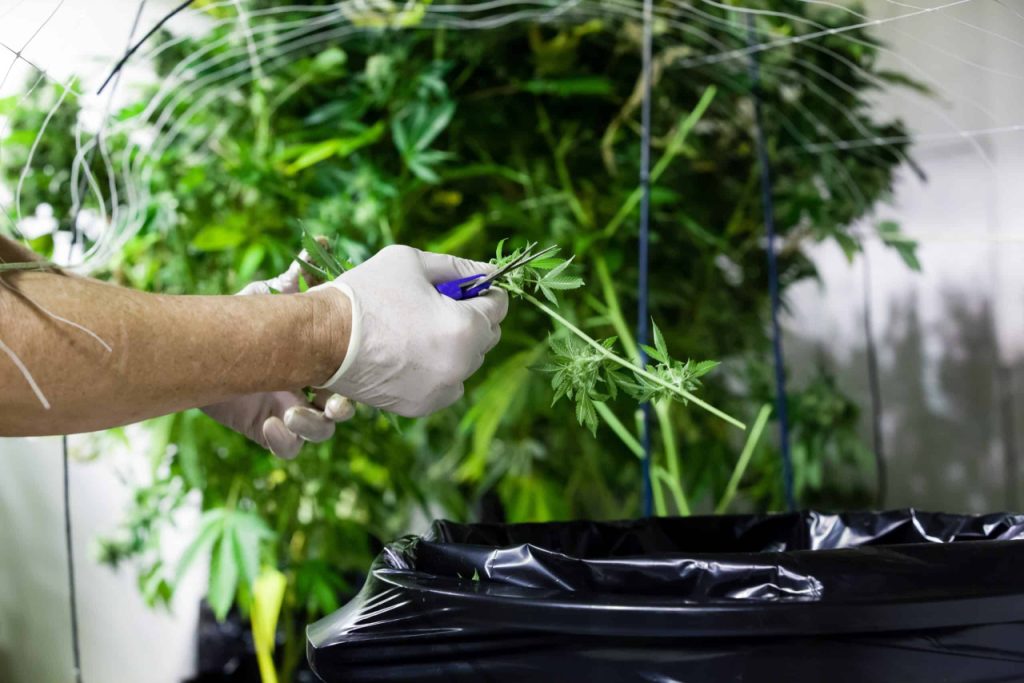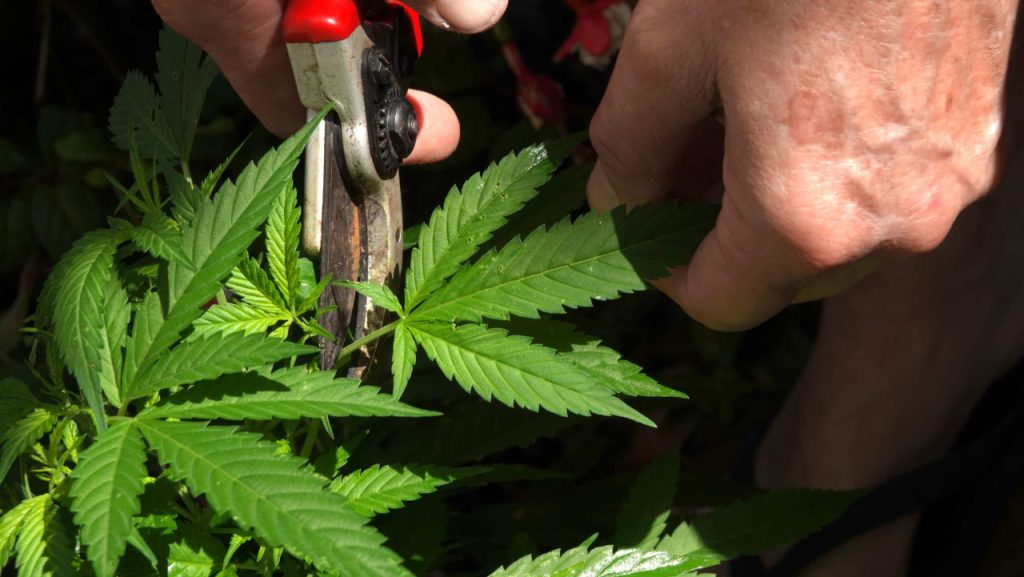Free Tropical Runtz seeds on orders over $150!
To defoliate autoflower plants you may need a little different approach to photoperiods due to their different growth patterns. Find out how and when to defoliate autoflowers here!
Growers always seek new methods to get the most out of their crops. Topping, super cropping, and mainlining are all frequent. Some people, however, use a process known as defoliation. Others may be hesitant to do it, but if successful, you may reap big profits. Also, the defoliation procedure is quick and easy.
Autoflower defoliation is the process of eliminating extra leaves from your plants. Plucking leaves from bushy branches allows more light to reach the buds and relieves some weight. It delivers more oxygen to the vital regions, producing a better crop. Some producers are hesitant to defoliate autoflower cannabis foliage since the leaves contain a significant amount of the plant’s nutrients. Lower yields might result from not knowing how to defoliate autoflowers, removing too much leaf, or doing the operation when it is not essential.
Additionally, defoliating autoflowers may cause more damage in outdoor settings since the leaves assist plants in recovering from pests and droughts. You have more control over the surroundings indoors, and the leaves can become an annoyance by taking up extra space and limiting light. Understanding how and when to defoliate autoflower plants allows you to get the most out of this operation.
While many producers are concerned about defoliation, the process has some advantages. With cautious hands, you can increase the likelihood of better yields. Defoliation can do this by shifting the energy of the plant. Cannabis plants do not have limitless energy. They can only acquire what they need from the sun and soil. The extra foliage inhibits the growth of the buds. Pruning the leaves might improve the cannabis harvest. Also, you can boost air circulation. Mold and pests may still infiltrate indoor plants. These pests like warm, humid environments and can injure your plants. As a result, the yield size may decrease. Humidity is reduced by boosting airflow between the branches. Mold and pest risks are reduced, and the quantity of healthy buds at the end increases. You could end up with some good cannabis.
Most producers usually wonder, “can I defoliate autoflowers?” Well, not all plants should be defoliated. Sick or slow-growing plants, for example, might suffer from the stress of the procedure. Cannabis must be healthy and powerful. When it comes to strains, the capacity to defoliate autoflowers is the most important consideration for every grower. Photoperiod strains, such as feminized seeds, are ideal for defoliation. They will recuperate and expand in time. However, autoflower plants do not allow you enough time to experiment with different training strategies. Even so, you may be surprised to find that defoliation may be done safely. It is vital to use caution because the process might be hazardous for this strain. Your yields should be safe as long as you defoliate at the proper time. The stress may temporarily inhibit development, but the plant may be kept healthy with a light touch. The buds can still blossom and are more powerful than before.
Defoliating autoflowers during the late blossom phase is not advised since the buds require as much energy as they can receive. The leaves contribute to the formation of resinous nugs as one of the nutrient storage facilities.
Because most buds are completely grown in the final blooming stage, pruning and cutting during this period will not result in a larger crop. Instead, you may degrade the quality of the buds that have already grown by taking one of their energy sources and destroying their foliage support.
When defoliating autoflowers during flowering, remember that cannabis plants naturally shed at this stage. Defoliation should also be avoided if the plant displays indications of stress or deficiency. In this case, methods such as low-stress training may be more useful.
Before you begin defoliating cannabis, you should acquire a few items. You don’t necessitate much equipment, and most of it is easily accessible for purchase. The main instrument is a good pair of scissors. Many people use curved trimming scissors for the greatest results, although a few growers prefer razor blades. While you may pluck or pinch the leaves with your hands, a sharp blade will allow you to be more precise. A smooth cut might also help the plant recuperate from stress faster. Naturally, razors or scissors should be maintained clean to avoid spreading disease. Rubbing alcohol based on ethanol is excellent for sterilizing your instruments.
The plant is another item on the list. The seeds you utilize should be defoliation-friendly. Your best bet is a hardy, bushy Indica strain. Of course, your hands should also be clean. A few people may purchase gloves to wear when defoliating cannabis. Gloves can help keep your hands from becoming sticky. Finally, it never hurts to have some duct tape on hand. The duct tape can restore the damage if you break or cut the stems by mistake.
The method of defoliating autoflowers is the same as it is for any other variety of cannabis. However, because autoflowers have a short vegetative stage, you have limited opportunity to correct faults. Remember that autoflower defoliation aims to assist your plants in concentrating energy and nutrients just where they are required. Every time you defoliate, regardless of the strain, you should take the following three steps:
The huge fan leaves are typically as large as your palm and have several pointed ends. In bushier greens, these large leaves use a lot of the plant’s energy and do more damage than good. They can hinder light from reaching the lower and middle sections, resulting in weaker bottom buds. The first stage in autoflower defoliation is to delicately snip off the large fan leaves on the middle and bottom stems. Your goal is to illuminate this region, so the lower branches do not remain in the shade. Avoid cutting fan leaves if the plant isn’t extremely bushy since they can provide the required protection. Cannabis plants benefit greatly from fan leaves. They are the photosynthetic powerhouse, functioning as large sponges for the light required by the buds to grow.

Additionally, when defoliating autoflowers, remove what is necessary. Aim for the largest fan leaves, as much area as possible on the bottom and center branches. If in doubt, remove a tiny fraction of the fan leaves, leaving at least two to three.
Next, eliminate the leaves that grow near the buds on the plant’s interior. They can create a shade on the blooms, preventing them from getting enough light. These leaves take up a lot of the plant’s vitality, leaving you with dead buds. Remove part of the autoflowers as you defoliate them to safeguard your smokables. These leaves also function as energy reservoirs for the buds and can save your plants if they become ill or malnourished. If you remove too many of them during autoflower defoliation, you risk limiting the development of your plant.
To defoliate autoflowers, carefully lift the canopy away from the plant and find the leaves towards the core of the plant. Cut anywhere from 10% to 15% of the leaves with your sanitized scissors. Your plant should still seem lush at this time, but the buds should have greater access to light and air. Even on a bushy plant, avoid cutting more than 20% since you risk nutrient lockout, creating more significant concerns.
Yellow, brown, withered, or shriveling leaves use the plant’s energy but do not improve the health of the buds. Removing old yellow leaves enhances circulation in the plant’s branches and supplies more nourishment to the blooms. If you have an abundance of yellow leaves, it might indicate a nutritional deficiency, therefore, avoid autoflower defoliation. Instead, concentrate on providing your plants with the necessary nutrients and evaluate defoliation after they’re healthy. Begin at the plant’s bottom and work your way up, ensuring to cut any large yellow leaves. New sprouts may have a yellow tint, but do not cut them. Remove a few leaves when defoliating autoflower plants to avoid hurting or straining your flora.

Your cannabis plants will look like a better structure once you’ve finished cutting up to the third node. Remove any old or yellow leaves. When you remove the dead foliage, you’ll have a better view of the buds without pushing through the fluff to check on them.
Trimming and pruning your plants at the appropriate times may greatly impact their health. Defoliating autoflowers allows them to spend less energy on maintaining dead, wilting, or superfluous leaves and more energy on nurturing buds. Knowing when and how to defoliate autoflower plants is critical since doing so too early or too late might cause harm. The optimal time to begin the procedure is during vegging and earlier blooming, but avoid pruning cannabis and trimming during late flowering. Since each strain has different requirements, not all cannabis plants require defoliation. This method can aid in producing a larger, fresher harvest, but it all comes down to high-quality cannabis seeds.





Offers
This product is not for use by or sale to persons under the age of 18. This product should be used only as directed on the label. It should not be used if you are pregnant or nursing. Consult with a physician before use if you have a serious medical condition or use prescription medications. A doctor’s advice should be sought before using any hemp products. All trademarks and copyrights are property of their respective owners and not affiliated with nor do they endorse this product. These statements have not been evaluated by the FDA. This product is not intended to diagnose, treat, cure or prevent any disease. By using this site you agree to follow the Privacy Policy and all Terms & Conditions printed on this site. All products contain less than 0.3% Cannabinoid-compliant with applicable Federal Laws. Please make yourself aware of any and all applicable laws regarding hemp in your jurisdiction. Premium Cultivars accepts no liability or responsibility regarding germination laws in any specific locale state or national jurisdictions.THCA products are not available for shipment to the following states: Hawaii, Idaho, Minnesota, Oregon, Rhode Island, Utah, Vermont *Note: Products with Total THC content above 0.3% must not be shipped to these states.
We want to help you get your hands on the seeds you want, take 20% off your next purchase when you enter your email below!
We want to help you get your hands on the seeds you want, take 20% off your next purchase when you enter your email below!